Josèfa Ntjam
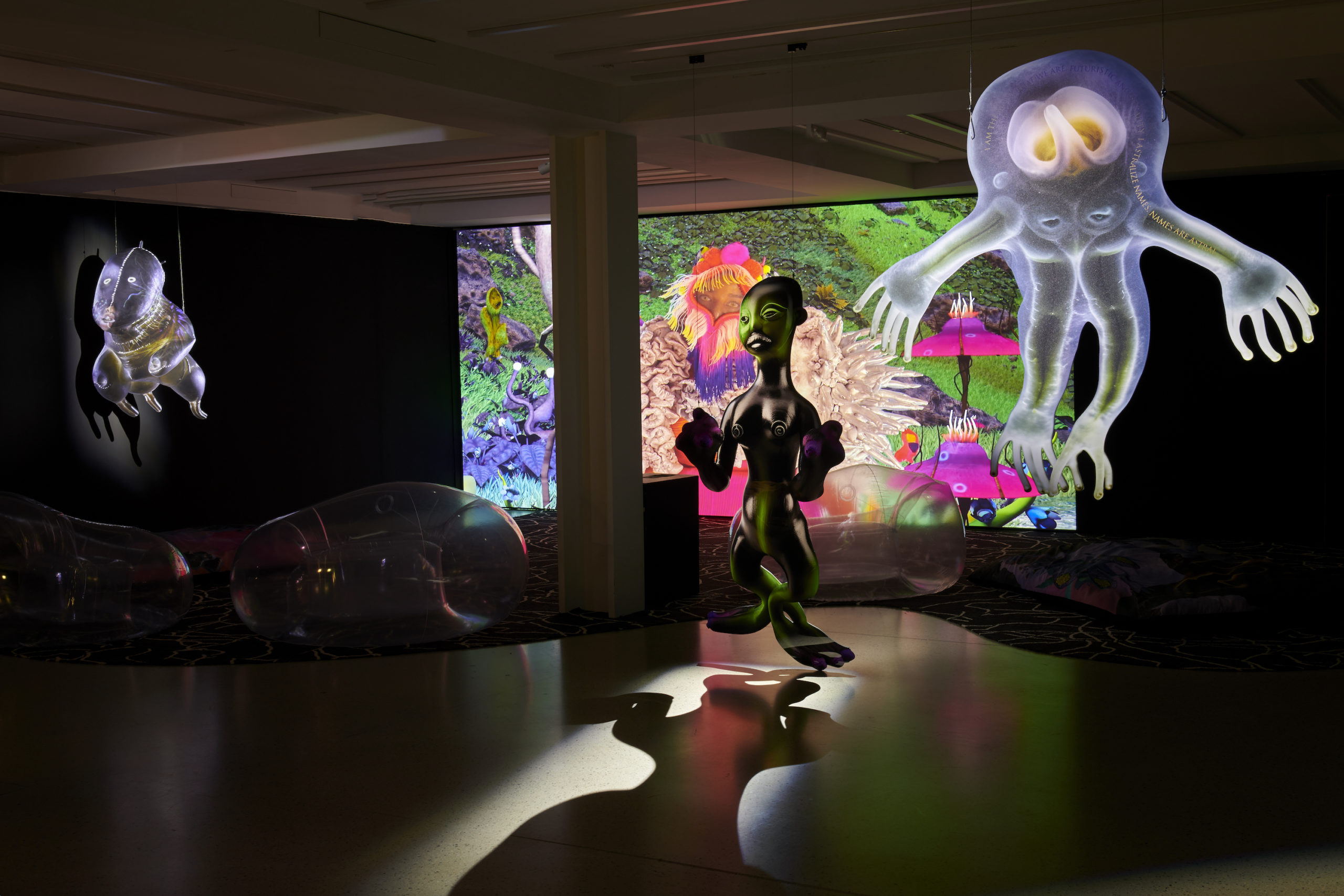
Incubating revolt.
Artist, performer and writer Josèfa Ntjam is the guest this winter at the Fondation Pernod Ricard in Paris, where she is taking part in a solo exhibition entitled “matter gone wild”, named after the title of the film-installation that forms its centrepiece. It’s an opportunity to sketch the portrait of an artist who belongs to the generation that grew up with the Internet, and who explores concepts of fluidity through biology, African mythology and science fiction. Although she has a predilection for performance readings – which allow her to embody the written word – and for photomontages, she uses a multitude of media: video, installation, performance, narration, music, sculpture and sound, which she combines to construct a total, immersive work, carrying a narrative that is the sum of all the pieces that make it up. Much of her work is digital, performative and narrative. It is marked by diverse influences ranging from Afrofeminism to futurist writing, from science fiction to web cultures, from Sun Ra to the television series Battlestar Galactica, from Detroit techno to African myths. There is no discontinuity between the artist’s first project and his most recent; they are all part of the same ecosystem, ‘world-works’ linked together by the incorporation of symbolic motifs, bright colours and abstract forms, which are all material for thought, often introspective. Texture, colour and form are used to subtly convey ideas and give rise to complex emotions.
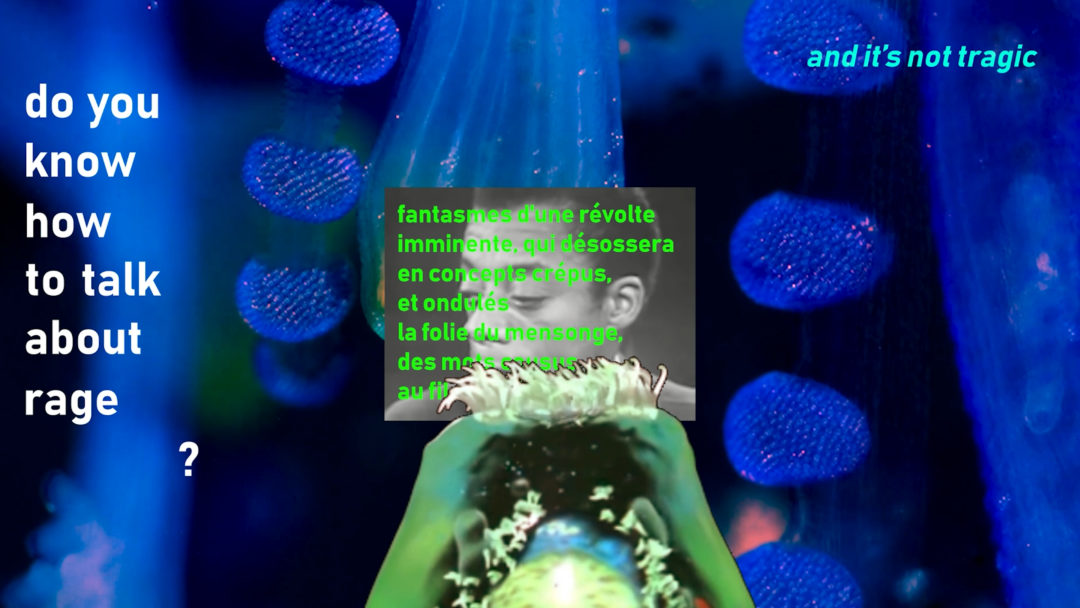
Josèfa Ntjam was born in Metz in 1992. She grew up in the Paris suburbs and now lives in Saint-Étienne, a change she admits is beneficial to her pace of production and reflection. Encouraged by her mother to draw – “When I was younger, my mother wanted to go to art school but couldn’t, so I think it was important for her to push us in that direction1“, she would later confide – it was through music, however, that she came to art. At the age of five, she enrolled at the Blanc-Mesnil Conservatoire, where she studied experimental contemporary music and the clarinet. She continued her training at the Pantin conservatoire, where she specialised in jazz. “I also did some singing and got into the habit of learning music by ear2“, she explains. It wasn’t until she went to art school3 that she put her musical training on hold. However, this explains the recurrent use of certain instruments in her performances, as well as the use of song and, more generally, the voice, which occupies a predominant place in her work. Her work can be defined as “multidisciplinary speculative writing4“, in the words of Barbara Sirieix. In each of her works, the artist invents possible futures in which the Western definition is no longer appropriate. “I am many”, she asserts in the video Mélas de Saturne (2020), and again in the film matter gone wild (2023). Escaping categorisation at all costs by blurring forms and identities is a sine qua non, a prerequisite. “We don’t need to define or justify ourselves; we tell ourselves what they want5“, writes Barbara Sirieix.
“All too often the subjects of experimentation, we have decided to build our own landscapes, to shift the gaze away from those accustomed to naming the ‘other’ without ever letting them express themselves6“, writes Josèfa Ntjam in the text accompanying her solo exhibition, “Sous la mangrove”, at the Mostra de Givors organised as part of the fifteenth Lyon Biennial, in 2019. Interested in speculating on the possibilities of human history and the cosmos – as zones of projection – the artist works on worlds and landscapes that she reconstructs. Drawing her inspiration and raw material from the Internet, natural science books and photographic archives, her modus operandi is the art of assemblage: words, sounds, stories, images, interweaving historical narratives from different times and places, derived from meticulous investigations, mathematical functions and philosophical thoughts, confronting them with African mythologies, ancestral rituals, religious symbolism, science fiction, the better to undo the grand narratives that carry the dominant discourses on origin, identity, race, in order to create new narratives and, through them, to reappropriate History. “Science fiction allows me to create in-between worlds,” she says. It is in the interstices, on the thresholds, on the margins, that she creates new worlds in which any system of perception of fixed identities is abolished, where gender and species are no longer defined, letting this plural voice be heard. The notion of interspecies runs through the artist’s work, and she is very interested in underwater plants, which are often in between animals and plants, like plankton, algae, and so on.
If her writing is omnipresent in her work, so too is that of the past. Each piece created by Josèfa Ntjam is always highly referential, often relating to mythologies linked to spaces that are revolutionary, as is the case at the Pernod Ricard Foundation, with Marthe Ekemeyong Moumié. This is the case at the Pernod Ricard Foundation, with Marthe Ekemeyong Moumié, a Cameroonian writer and activist who was one of the leading figures in the fight for independence in 1960, Mami Wata, the aquatic divinity of the African voodoo cult, and Persona, all of whom are guides, “singers of rebellious, ancestral and forward-looking revolts7“.
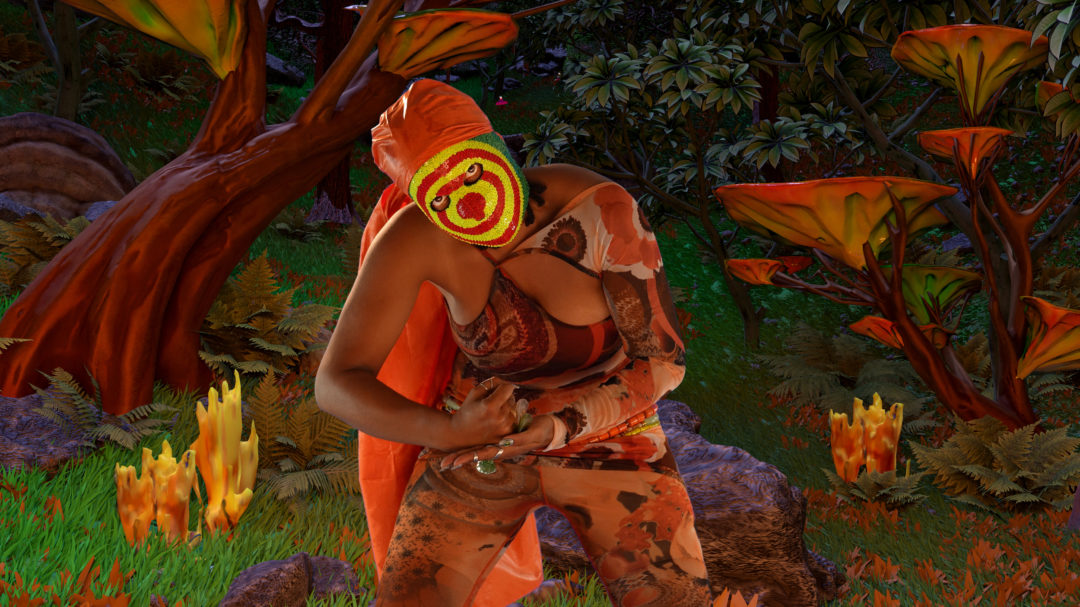
Articulating, juxtaposing, hybridizing: Josèfa Ntjam’s work owes much to photomontage. Her photomontages, which are presented in series and made up of archive photographs, 3D scans of objects and microscopic views of organic materials, evoke opulent universes in which the macro and the micro come together through the accumulation and succession of different layers, documents relating to historical events and representations of ancient African divinities, all merging in a broad tableau of cellular forms and aquatic elements, between the processes of molecular division, coagulation, proliferation and micro-organisation that spread within the disparate cells of society to infiltrate and contaminate the dominant political bodies.
Her move to Saint-Étienne brought her closer to nature. Her regular walks in the forest enabled her to observe polypores in particular. With the help of books on botany and plant remedies, she took samples to make her pieces. In one of her first performances, Plantes en révoltes (2018), she revisited the narratives of certain independence struggles by staging dissident stories of hybrid plants and weeds, through photomontages made from images of rare species from a family botany book. “I am a bad weed, one of those that grow through concrete”, she wrote in large letters on the walls of the Couvent in Marseille’s Belle-de-Mai district, along with the rest of the poem Ortiaune from which the phrase is taken. From the chaos emerges a new incandescent language, both visual and sonic, plural.
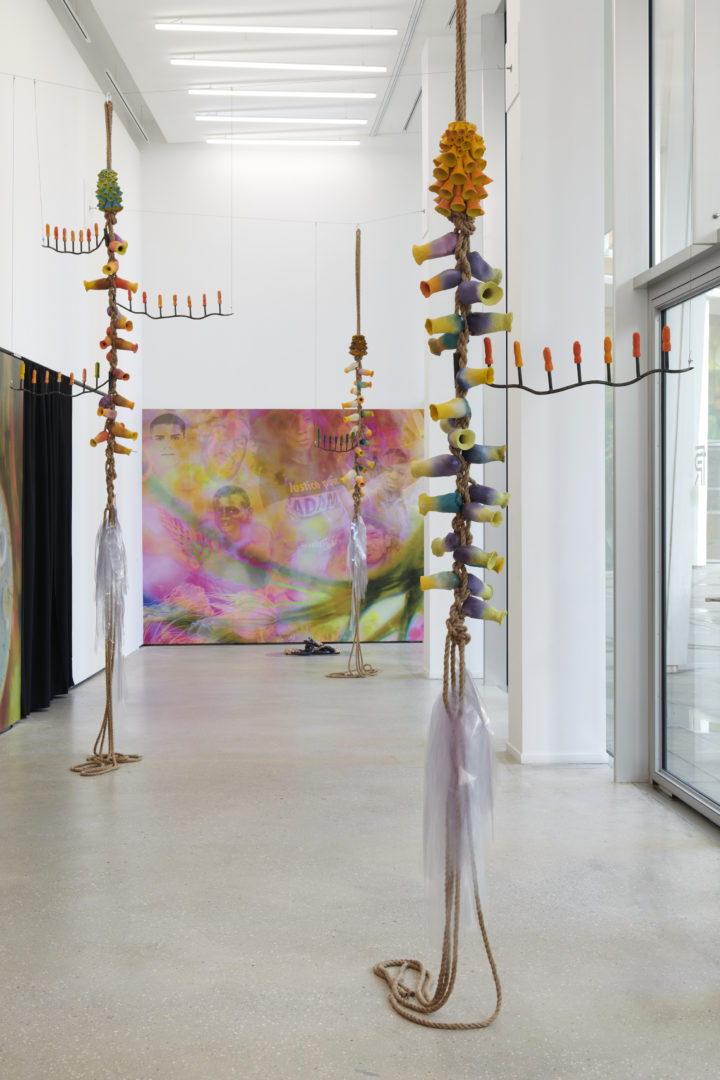
© ADAGP, Paris, 2023. Crédit Photo Marc Domage.
In 2020, the year she was nominated for the Aware Prize, Josèfa Ntjam directed the video Quantum Mecanic, commissioned by the Ateliers Médicis in Clichy-sous-Bois. The following year, I am Nameless, an incantatory reading that questions notions of collectivity and individuality, served as a manifesto for her work, which revolves around the hybridisation and interconnection of real and fictional worlds. She performs her readings in order to embody the writing.
In Branchements de Sokhna #2 (2022), she pays homage to the women warriors of Dahomey, now Benin, a group of revolutionary women who fought against colonial invasion. Taking up these feminist forms of resistance is important to her. “It’s also a question of societies that were quite matriarchal at the time. That’s why they are women warriors8“, she explains, before adding: “It’s important to bring back these characters who existed and to put them in a new context, and also to put them in echo and resonance with other characters from current struggles and, as a result, to create this network of resistance.”
At the Pernod Ricard Foundation, she returned to the ceramics she had experimented with at the start of her studies in Bourges. In Saint-Étienne, she is working with artists Sean Hart and Nicolas Pirus to design the Aquatic Invasion production house, turning her adopted city into an ecosystem with alliances of thought. This underlines the importance of collective work for the artist who is a member of the Black(s) to the Future collective, which deploys Afrofuturism as a collective research practice, based on a notion of writing and storytelling around rebellion, the question of how to break out of the box, how to thwart subjugated assignments. “Je suis plusieurs” also stems from this collective impulse. Because research is an integral part of her artistic practice, she has developed a collaborative way of working. One of the challenges of “matter gone wild”, explains Mawena Yehouessi, the exhibition’s curator, is “to remind us of what lurks behind the spotlights of the ‘official’ election, and to remind us how many of us are there and how many of us remain there, fighting the dreary nonsense of an inclusion conditional on the prior renunciation of our ‘minority’ or ‘marginal’ communities: wild and barbaric, suburban and shamanic, eccentric and paradoxical9“.
Mixing public images and private archives, the film Dislocation (2022) deals with the war of independence in Cameroon, a story of silence that touches on the intimate. What does it mean for first- and second-generation children to live in the land that colonised their parents? To address a story that concerns her personally, she uses the metaphor of plants, recalling that the struggle was the maquis, and that the revolutionary maquis in Cameroon was the Bassa forests. The stories of plants are also stories of revolts and revolutions.
Somewhere between genesis and a science-fiction future, Josèfa Ntjam imagines other possible worlds by fusing fictional, political, futuristic and radical stories, other worlds in which infiltration and revolt are survival strategies. Between underwater civilisations and intergalactic journeys, mythologies and poetry, the artist offers a different experience of art, asserting his political commitment with a plural voice. At the Pernod Ricard Foundation, “”matter gone wild” is to be seen as a training ground for insurrection – imaginary and memorial”, explains Mawena Yehouessi. Visitors are greeted by “incubators of revolt”, a kind of cell with unstable floors and seats that require the body to be physically involved. This uncomfortable position encourages visitors to rediscover the courage to go out and demonstrate, to dare to get involved. These days, rebellion as a means of emancipation seems to be the best way of inventing a desirable future.
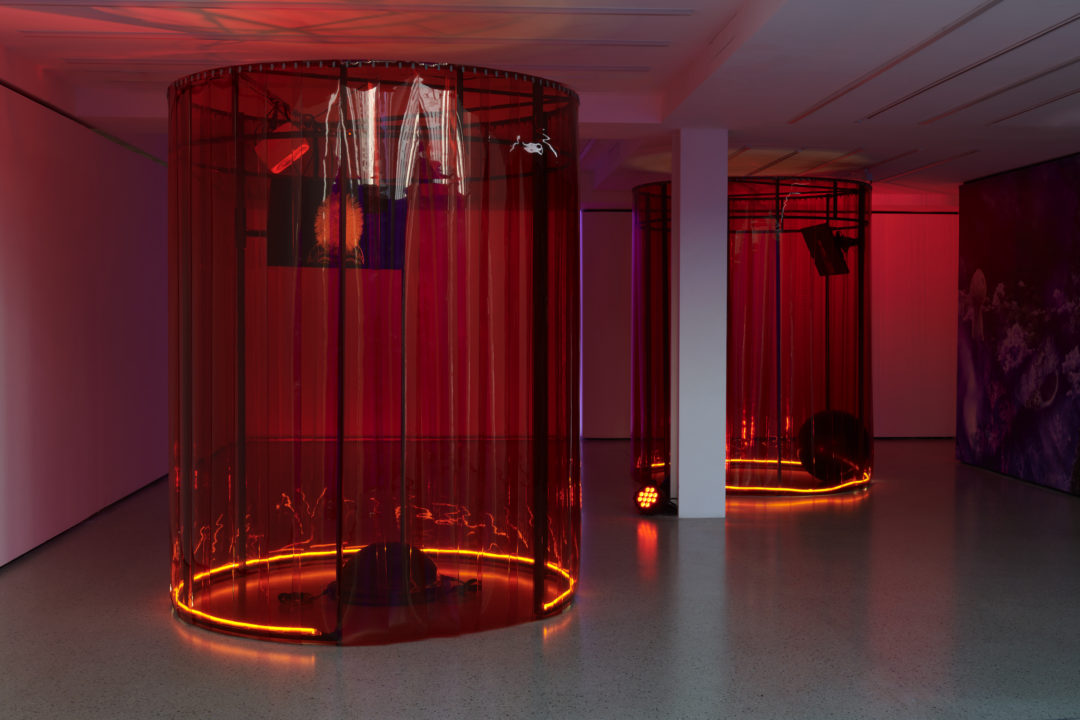
© ADAGP, Paris, 2023. Crédit Photo Marc Domage.
1 Indira Béraud, « Conversation avec Josèfa Ntjam », Figure figure, no 23, janvier 2020, [en ligne] : https://figurefigure.fr/media/pages/archives/january-2020/a1f8376224-1599751546/figurefigure23josefantjam.pdf
2 Ibid.
3 Elle intègre d’abord l’École supérieure d’art et de design d’Amiens et l’Institut supérieur des arts et des cultures (ISAC) de l’université Cheikh-Anta-Diop de Dakar au Sénégal, avant de rejoindre l’École nationale supérieure d’art (ENSA) de Bourges d’où elle est diplômée en 2015, puis l’École supérieure nationale supérieure d’arts de Paris-Cergy (ENSAPC) d’où elle est diplômée en 2017.
4 Barbara Sirieix, « Prix Aware – Josèfa Ntjam nommée au Prix 2020 », [en ligne] : https://awarewomenartists.com/artiste_prixaware/josefa-ntjam/
5 Ibid.
6 Josèfa Ntjam, extrait du texte accompagnant l’exposition« Sous la Mangrove », Mostra de Givors, quinzièmeBiennale de Lyon, 2019.
7 Mawena Yehouessi, matter gone wild, texte accompagnant l’exposition éponyme, Fondation d’entreprise Pernod Ricard, Paris, 14.11.2023 au 27.1.2024.
8 « À Art Basel, Josèfa Ntjam rend hommage aux guerrières du Dahomey », Brut, 21 septembre 2022, https://www.brut.media/fr/entertainment/a-art-basel-josefa-ntjam-rend-hommage-aux-guerrieres-du-dahomey-a2450469-89e0-48ca-8e36-fe0dbb4b7bd0
9 Mawena Yehouessi, op. cit.
______________________________________________________________________________
Head image : Joséfa Ntjam, matter gone wild, 2023, vue d’exposition, Fondation Pernod Ricard, Paris.
© ADAGP, Paris, 2023. Crédit Photo Marc Domage.
- From the issue: 107
- Share: ,
- By the same author: Laurent Proux, Michel François , Adrien Vescovi, Taysir Batniji,
Related articles
Iván Argote
by Patrice Joly
Laurent Proux
by Guillaume Lasserre
Diego Bianchi
by Vanessa Morisset

